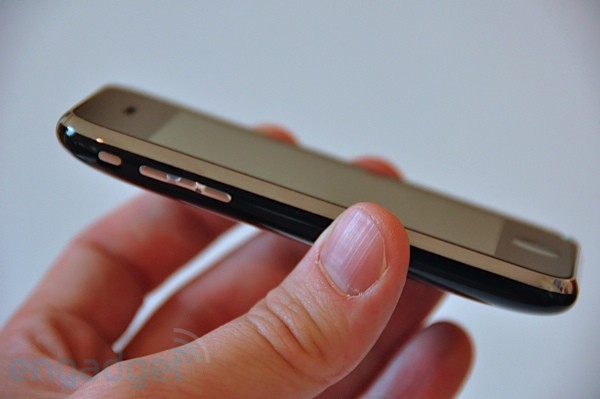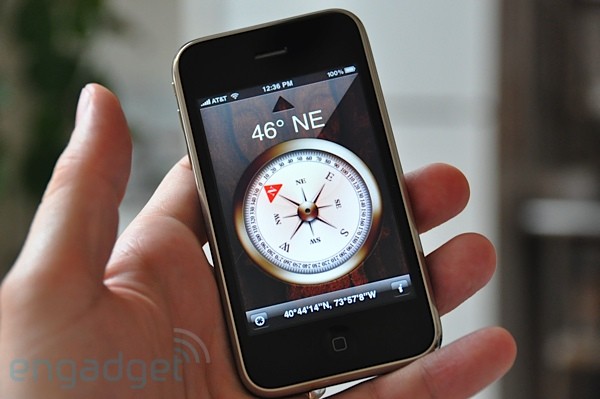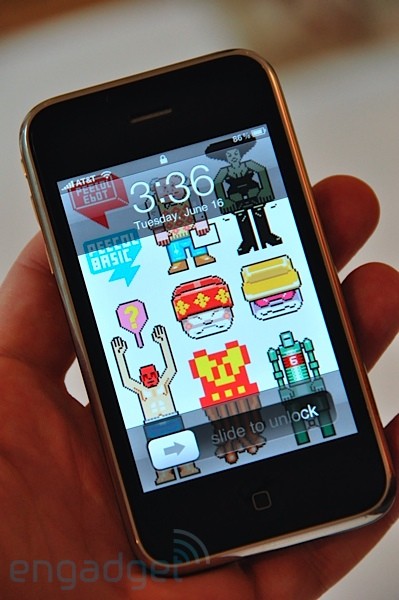If it ain’t broke, don’t fix it — right? We know countless reviews of the iPhone 3GS may begin with that cliché, but there’s little chance you’d find a better way to describe the strategy that Apple has just put into play with its latest smartphone. In many ways, the 3GS is a mirror image of the iPhone 3G; externally there’s no difference. It’s inside where all the changes have happened, with Apple issuing a beefed-up CPU, new internal compass, larger capacities for storage, and improved optics for its camera. More to the point, the release of the 3GS coincides with the launch of iPhone OS 3.0, a major jump from previous versions of the system software featuring highly sought after features like cut, copy, and paste, stereo Bluetooth, MMS, tethering, video recording, landscape keyboard options for more applications, and an iPhone version of Spotlight. At a glance, what Apple seems to be doing is less a reinvention of the wheel and more like retreading the wheel it’s already got (and what a wheel, right?). So, do the iPhone 3GS and OS 3.0 tweak the details in just the right places, or has Apple gone and gotten lazy on us? Read on to find out.
Hardware
As we said in the intro, there is nothing visually different about the iPhone 3GS versus the iPhone 3G, save for the lettering on the back, which is now mirrored like the Apple logo. While we had seen leaked images of a matte finish, bezel-free version of the device, when push came to shove, what we got was essentially a carbon copy of the iPhone 3G. In terms of the general elements of the phone — the plastic casing, mute switch, home and power buttons, etc. — there is no change at all. In fact, if you were to lay this phone and its predecessor next to one another face up, the new model would be indistinguishable. Of course, the 3GS is not just a clone of the previous device, and Apple has made most of its significant changes inside the phone.
Internals

First off, the company has supercharged the CPU of the 3GS (remember, the S is for speed), jacking up the processor numbers from 412MHz to a rumored 600MHz. Additionally, the RAM is said to have doubled from 128MB to 256MB, the phone is offered with 16GB or 32GB of storage, and Apple has swapped out the previous graphics chip for a new version — dubbed the PowerVR SGX — which adds support for more robust visuals via OpenGL ES 2.0. All this should mean that end users will see a noticeable difference in app speeds and loading times (Apple claims an average of 2x faster loads, though since the company has been cagey about upgrade details, it’s hard to know what the real differences are).
So, do the revamped insides equal an improved experience on the phone? Kinda.
For our oft-used phone actions — flicking through homescreens, calling up search terms in Spotlight, scrolling through long lists — we definitely felt like the 3GS was snappier than its predecessor. It wasn’t like the doors were flying off, but there was a noticeable bump in speed, particularly when it came to initial data loads (how quickly you see content pop up within an application). When it came to opening apps which pull lots of that kind of content, like Contacts, Calendar, or Messaging, we saw an even more noticeable improvement. Comparing the 3G and 3GS side-by-side yielded small but absolutely palpable differences — the 3GS does seem to eliminate quite a few of the hangs we find maddening as we go through our day. It’s not the perfect salve, but it’s a start.
We’re excited by the cranked up CPU, but in our experience you’ll see lowered load times (though obviously not as drastic) if you take a standard 3G and do a full restore, so there is the lingering question of whether or not the jacked-up feel of the 3GS will last, or will begin to bog down after months of use and heaps of data.
We mentioned that Apple didn’t really make any cosmetic changes to the phone, but that’s not entirely accurate. While the 480 x 320 display on the iPhone 3GS is technically identical to its predecessor’s screen, it adds one small feature which should make some users extremely happy.
The company has changed the treatment on the surface of the touchscreen, utilizing an oleophobic coating — essentially a protectant that’s highly resistant to fingerprint smudging. For those of you constantly wiping burger grease, WD40, and various other toxic materials from your iPhone, this will come as a tremendous little perk. The most surprising thing about the tech is that it actually does what the company says it will: namely, it resists new smudges and wipes almost entirely clean with a single swipe on a pant leg. This wasn’t exactly the most pressing issue we had with the phone, but it’s nice to know that Apple is innovating in the dirty screen space.
Camera
A camera tweak is a big deal for iPhone fans — after all, they’ve had to suffer through not one, but two iterations of a phone with a paltry 2 megapixel camera, no autofocus, and no flash. Apple has tweaked two out of three here, and as Meat Loaf tells us, that ain’t bad. The 3GS upgrades the built-in camera to a 3 megapixel version — not insanely great, but at least competitive — and has added an autofocus function with a nifty software tie-in. Instead of having to use a gross physical button to snap your shots, the iPhone continues to rely on its onscreen trigger, but cranks up the use of that big display by allowing you to focus in on subjects based on where you tap. In our experience, the parlor trick actually turned out to be quite useful, accurately zeroing in on what we wanted most of the time. Struggles to focus were minor at best, though you won’t be able to do any heavy macro work here, and during video recording you’re stuck with a constantly focusing lens — no tapping allowed.
Battery life, pricing, wrap-up
Battery life
Apple claimed that the battery life on the 3GS is somehow better than what we’ve previously seen on the 3G, but in our tests, we could barely tell the difference between the two handsets. First off, in terms of talktime and data over a 3G network, the count is exactly the same (five hours) — though the battery gains two hours (up from 10 to 12) using 2G. Where the differences really show according to Apple are during strictly WiFi, video, or audio use. The claim is that you’ll see roughly three to four more hours of life out of the device in those scenarios, but honestly, if you’re just using this thing to play audio, why did you bother getting an iPhone? In our tests — real world, admittedly non-scientific tests — we hardly noticed a difference in battery life between the new and old model. The point is, you’re still very much in the same boat when it comes to general use — but on the plus side, there’s no noticeable deficit in power with the new version (though we have yet to see what heavy video capture does to a full charge).
Pricing
As with any phone, the big, highlighted number you see advertised left and right for the iPhone 3GS — $199 for the 16GB version and $299 for the 32GB — is the new contract price, which means there are plenty of thick, barbed strings attached. If you’re still using a RAZR from 2006 and you haven’t touched your service or bought a new phone directly from the carrier since then, you’re almost certainly in business with these maximum subsidies; AT&T’s made its money off of you several times over and it’s willing to put a little dough back in your pocket once again in order to get a whole lot more out of you over the course of a contract. On the flipside, customers who have been upgrading religiously from iPhone to 3G to 3GS will not necessarily be eligible for those most lucrative prices unless they paid the off-contract price for their 3G (to avoid re-upping the contract they were already on) and are now out of contract altogether — unless AT&T says otherwise, of course. More on that next.
If you’re what AT&T calls “ineligible,” you have a a few options. The company has taken the very unusual step of letting iPhone 3G customers who are becoming upgrade eligible in the next three months through the end of September (note that this can be, and usually is, different from the date that your contract is up) can take advantage of the fully subsidized pricing. The way your upgrade eligibility date is an inexact science, involving Magic 8-Balls, mainframes from the 1960s, and faerie dust, but the bottom line is that you need to check with the carrier to find out when that date is (you can see it using online account management — no need to call in).
You can always add a line, assuming you clear the usual battery of credit checks, which would also get you back in the game for $199 / $299 — the tradeoff being that you’re stuck with another line of service, of course, which ends up significantly outweighing any subsidy advantage upfront by the time your new contract has run its course. If you want to upgrade your existing line early, you can do so for $399 or $499 for the 16GB or 32GB model, respectively, and for contract breakage newbies, that can definitely be an unwelcome shock to the wallet. Even folks who upgraded from the original iPhone to the 3G and don’t become eligible in the next few months won’t much appreciate what’s going on here, since they’d essentially paid “full price” for the first model which allowed AT&T to offer the 3G at maximum subsidy provided customers re-upped their contracts. At any rate, keep in mind that buying in at these $399 / $499 price points will extend your contract back to two years, because — believe it or not — they’re still slightly discounted. If you want to buy a 3G S outright without the moral and financial dilemma of signing your name to a very pricey piece of paper, get ready for the big bucks: $599 or $699, depending on the model you choose.
It can all be a little confusing, yes — and if you aren’t upgrade eligible or have questions about your individual situation, your best bet is to go into a store; representatives can typically work magic on your account that you can’t work yourself through AT&T’s website.
Wrap-up

There are probably two very large groups of people thinking about buying an iPhone right now. One set is current users, either those with the 3G, or those still using the original model. The other set is a group of new users — people who’ve never owned an iPhone and are now faced with not one, but two different options when it comes to getting in the door. For both groups, there are huge questions to answer about whether or not getting the 3GS makes sense, and very few of them have to do with the quality of the phone.
For current users, we have this to say: the iPhone 3GS is a solid spec bump to a phone you already own… but it is, at its core, a phone you already own. Your real deciding factors will be two-fold, first, are you able to purchase the 3GS at a price which is reasonable or sensible to you? For a lot of current users — particularly more recent customers — the pricing will be exorbitant, and it’s hard to think of dropping $399 or $499 when you’ve just shelled out for a very, very similar phone (remember, you’re paying for a speed bump, a compass, and video recording). On the other hand, if you’re within contract renewal range and you don’t plan on jumping platforms anytime soon, $199 nabs you an unquestionably excellent smartphone.
That conclusion speaks to new users who are undecided about the iPhone (or exactly which iPhone to buy). At this stage, we wouldn’t recommend anything but the 3GS for newcomers planning on getting into Apple’s game. For another $100, you’re nabbing a much more robust device with a handful of great additions. It’s a small price to pay for something you plan to keep long term — or until Apple pops the next iteration on us. The other big questions here aren’t about the 3G or 3GS — they’re about Apple’s platform and AT&T’s network. While the smartphone market has cracked wide open lately, the iPhone is arguably the market leader (at least in mindshare), and really does showcase a superb platform — lack of physical keyboard and multitasking aside. AT&T, on the other hand, isn’t exactly acting like the top-tier carrier it’s supposed to be, and its service can sometimes be maddeningly poor.
So while it’s tough to argue with the package Apple has put together (a stellar device with just enough new to make it nearly perfect), we couldn’t help feeling a bit let down by the 3GS. Maybe we’ve been spoiled by devices like the Pre and Ion (and it’s possible we’re a little numb to OS 3.0 since we’ve played with the beta for a while now), but the additions of video recording, a compass, and a speed bump just don’t seem that compelling to us. The mix of new features and a ever-growing App Store will still be potent to new buyers — but pricing schemes which amount to hundreds more for current owners might give previous early adopters and eager upgraders reason for pause. Ultimately we’re not saying it’s time to jump ship, but we’ve come to expect a bit more pedal to the floor from Apple — you’ve raised the bar guys, now it’s time to jump over it.


